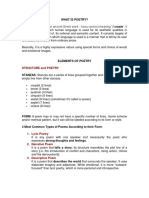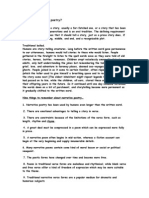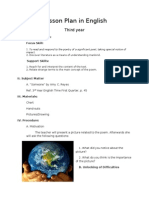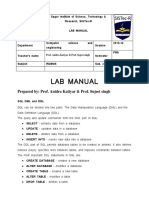Poetry Is A Form of Literature That Uses Aesthetic and Rhythmic Qualities of Language
Poetry Is A Form of Literature That Uses Aesthetic and Rhythmic Qualities of Language
Uploaded by
Monica Marquez PolicarpioCopyright:
Available Formats
Poetry Is A Form of Literature That Uses Aesthetic and Rhythmic Qualities of Language
Poetry Is A Form of Literature That Uses Aesthetic and Rhythmic Qualities of Language
Uploaded by
Monica Marquez PolicarpioOriginal Description:
Original Title
Copyright
Available Formats
Share this document
Did you find this document useful?
Is this content inappropriate?
Copyright:
Available Formats
Poetry Is A Form of Literature That Uses Aesthetic and Rhythmic Qualities of Language
Poetry Is A Form of Literature That Uses Aesthetic and Rhythmic Qualities of Language
Uploaded by
Monica Marquez PolicarpioCopyright:
Available Formats
Poetry is a form of literature that uses aesthetic and rhythmic qualities of language—such as phonaesthetics, sound symbolism, and metre—to
evoke
meanings in addition to, or in place of, the prosaic ostensible meaning. Poetry has a long history, dating back to the Sumerian Epic of Gilgamesh.
Elements of Poetry
STRUCTURE and POETRY
An important method of analyzing a poem is to look at the stanza structure or style of a poem. Generally speaking, structure has to do with the overall
organization of lines and/or the conventional patterns of sound. Again, many modern poems may not have any identifiable structure (i.e. they are free
verse), so don't panic if you can't find it!
STANZAS: Stanzas are a series of lines grouped together and separated by an empty line from other stanzas. They are the equivalent of a paragraph in
an essay. One way to identify a stanza is to count the number of lines. Thus:
couplet (2 lines)
tercet (3 lines)
quatrain (4 lines)
cinquain (5 lines)
sestet (6 lines) (sometimes it's called a sexain)
septet (7 lines)
octave (8 lines)
FORM: A poem may or may not have a specific number of lines, rhyme scheme and/or metrical pattern, but it can still be labeled according to its form or
style. Here are the three most common types of poems according to form:
1. Lyric Poetry: It is any poem with one speaker (not necessarily the poet) who expresses strong thoughts and feelings. Most poems,
especially modern ones, are lyric poems.
2. Narrative Poem: It is a poem that tells a story; its structure resembles the plot line of a story [i.e. the introduction of conflict and
characters, rising action, climax and the denouement].
3. Descriptive Poem: It is a poem that describes the world that surrounds the speaker. It uses elaborate imagery and adjectives. While
emotional, it is more "outward-focused" than lyric poetry, which is more personal and introspective.
Ode: It is usually a lyric poem of moderate length, with a serious subject, an elevated style, and an elaborate stanza pattern.
Elegy: It is a lyric poem that mourns the dead. [It's not to be confused with a eulogy.]It has no set metric or stanzaic pattern, but it usually begins by
reminiscing about the dead person, then laments the reason for the death, and then resolves the grief by concluding that death leads to immortality. It
often uses "apostrophe" (calling out to the dead person) as a literary technique. It can have a fairly formal style, and sound similar to an ode.
Sonnet: It is a lyric poem consisting of 14 lines and, in the English version, is usually written in iambic pentameter. There are two basic kinds of sonnets:
the Italian (or Petrarchan) sonnet and the Shakespearean (or Elizabethan/English) sonnet. The Italian/Petrarchan sonnet is named after Petrarch, an
Italian Renaissance poet. The Petrarchan sonnet consists of an octave (eight lines) and a sestet (six lines). The Shakespearean sonnet consists of three
quatrains (four lines each) and a concluding couplet (two lines). The Petrarchan sonnet tends to divide the thought into two parts (argument and
conclusion); the Shakespearean, into four (the final couplet is the summary).
Ballad: It is a narrative poem that has a musical rhythm and can be sung. A ballad is usually organized into quatrains or cinquains, has a simple rhythm
structure, and tells the tales of ordinary people.
Epic: It is a long narrative poem in elevated style recounting the deeds of a legendary or historical hero.
Other types of poems include:
Haiku: It has an unrhymed verse form having three lines (a tercet) and usually 5,7,5 syllables, respectively. It's usually considered a lyric
poem.
Limerick: It has a very structured poem, usually humorous & composed of five lines (a cinquain), in anaabba rhyming pattern; beat must
be anapestic (weak, weak, strong) with 3 feet in lines 1, 2, & 5 and 2 feet in lines 3 & 4. It's usually a narrative poem based upon a short and
often ribald anecdote.
SOUND PATTERNS
Three other elements of poetry are rhyme scheme, meter (ie. regular rhythm) and word sounds (like alliteration). These are sometimes collectively
called sound play because they take advantage of the performative, spoken nature of poetry.
RHYME
Rhyme is the repetition of similar sounds. In poetry, the most common kind of rhyme is the end rhyme, which occurs at the end of two or more lines. It is
usually identified with lower case letters, and a new letter is used to identify each new end sound. Take a look at the rhyme scheme for the following
poem :
I saw a fairy in the wood,
He was dressed all in green.
He drew his sword while I just stood,
And realized I'd been seen.
The rhyme scheme of the poem is abab..
Internal rhyme occurs in the middle of a line, as in these lines from Coleridge, "In mist or cloud, on mast or shroud" or "Whiles all the night through fog-
smoke white" ("The Ancient Mariner"). Remember that most modern poems do not have rhyme.
NOTE: Rhyme (above) and rhythm (below) are two totally different concepts!
RHYTHM AND METER
Meter: the systematic regularity in rhythm; this systematic rhythm (or sound pattern) is usually identified by examining the type of "foot" and
the number of feet.
1. Poetic Foot: The traditional line of metered poetry contains a number of rhythmical units, which are called feet. The feet in a line are
distinguished as a recurring pattern of two or three syllables("apple" has 2 syllables, "banana" has 3 syllables, etc.). The pattern, or foot, is
designated according to the number of syllables contained, and the relationship in each foot between the strong and weak syllables.Thus:
__ = a stressed (or strong, or LOUD) syllable
U = an unstressed (or weak, or quiet) syllable
In other words, any line of poetry with a systematic rhythm has a certain number of feet, and each foothas two or three syllables with
a constant beat pattern .
a. Iamb (Iambic) - weak syllable followed by strong syllable. [Note that the pattern is sometimes fairly hard to maintain, as in the
third foot.]
b. Trochee (Trochaic): strong syllable followed by a weak syllable.
c. Anapest (Anapestic): two weak syllables followed by a strong syllable.
e.g.
In her room at the prow of the house
Where light breaks, and the windows are tossed...
From "The Writer", by Richard Wilbur
d. Dactyl (Dactylic): a strong syllable followed by two weak syllables.
DD
e. Spondee (Spondaic): two strong syllables (not common as lines, but appears as a foot). A spondee usually appears at the end
of a line.
2. The Number of Feet: The second part of meter is the number of feet contained in a line.
Thus:
one foot=monometer
two feet=dimeter
three feet=trimeter
four feet=tetrameter
five feet=pentameter
six feet=hexameter (when hexameter is in iambic rhythm, it is called an alexandrine)
Poems with an identifiable meter are therefore identified by the type of feet (e.g. iambic) and the number of feet in a line (e.g.
pentameter). The following line is iambic pentameter because it (1) has five feet [pentameter], and (2) each foot has two syllables with the
stress on the second syllable [iambic].
That time | of year | thou mayst | in me | behold
Thus, you will hear meter identified as iambic pentameter, trochaic tetrameter, and so on.
3. Irregularity: Many metered poems in English avoid perfectly regular rhythm because it is monotonous. Irregularities in rhythm add interest
and emphasis to the lines. In this line:
The first foot substitutes a trochee for an iamb. Thus, the basic iambic pentameter is varied with the opening trochee.
4. Blank Verse: Any poetry that does have a set metrical pattern (usually iambic pentameter), butdoes not have rhyme, is blank verse.
Shakespeare frequently used unrhymed iambic pentameter in his plays; his works are an early example of blank verse.
5. Free Verse: Most modern poetry no longer follows strict rules of meter or rhyme, especially throughout an entire poem. Free verse, frankly,
has no rules about meter or rhyme whatsoever! [In other words, blank verse has rhythm, but no rhyme, while free verse
has neither rhythm nor rhyme.] So, you may find it difficult to find regular iambic pentameter in a modern poem, though you might find it in
particular lines. Modern poets do like to throw in the occasional line or phrase of metered poetry, particularly if they’re trying to create a certain
effect. Free verse can also apply to a lack of a formal verse structure.
WORD SOUNDS
Another type of sound play is the emphasis on individual sounds and words:
Alliteration: the repetition of initial sounds on the same line or stanza - Big bad Bob bounced bravely.
Assonance: the repetition of vowel sounds (anywhere in the middle or end of a line or stanza) - Tilting at windmills
Consonance: the repetition of consonant sounds (anywhere in the middle or end of a line or stanza) - And all the air a solemn stillness
holds. (T. Gray)
Onomatopoeia: words that sound like that which they describe - Boom! Crash! Pow! Quack! Moo!Caress...
Repetition: the repetition of entire lines or phrases to emphasize key thematic ideas.
Parallel Stucture: a form of repetition where the order of verbs and nouns is repeated; it may involve exact words, but it more importantly
repeats sentence structure - "I came, I saw, I conquered".
You might also like
- Different Types of PoetryDocument22 pagesDifferent Types of Poetryrehmania78644100% (3)
- Comolli, Jean-Luc and Narboni, Paul. Criticism. Screen.2Document12 pagesComolli, Jean-Luc and Narboni, Paul. Criticism. Screen.2Kateryna SorokaNo ratings yet
- Allomorph DefinitionDocument2 pagesAllomorph DefinitionSyafiqah Matyusof100% (2)
- What Is Poetry? PoetryDocument8 pagesWhat Is Poetry? PoetryJun HagonosNo ratings yet
- Structure and PoetryDocument13 pagesStructure and PoetrySherwinNo ratings yet
- Elements of Poetry: Form Sound Devises Imagery Mood/ Tone ThemeDocument21 pagesElements of Poetry: Form Sound Devises Imagery Mood/ Tone ThemeRoel Chul Su Bosito0% (1)
- FormalismDocument13 pagesFormalismNam DaoNo ratings yet
- Graphic NovelsDocument46 pagesGraphic Novelsapi-271284966No ratings yet
- Lesson 2: General Types and Forms of Literature: A. Prose Fiction B. Poetry C. Drama D. Nonfiction ProseDocument4 pagesLesson 2: General Types and Forms of Literature: A. Prose Fiction B. Poetry C. Drama D. Nonfiction ProseMelNo ratings yet
- Lesson Plan The Inevitable Day1Document5 pagesLesson Plan The Inevitable Day1Mark Jason OrtizNo ratings yet
- Types of PoemsDocument6 pagesTypes of PoemsashiyatokugawaNo ratings yet
- What Is Narrative PoetryDocument1 pageWhat Is Narrative PoetryemilyjaneboyleNo ratings yet
- Basic Elements of Short StoryDocument15 pagesBasic Elements of Short StoryMark LorestoNo ratings yet
- 21st Century LiteratureDocument5 pages21st Century LiteratureEmille GepigonNo ratings yet
- Chapter 4-Literary CriticismDocument8 pagesChapter 4-Literary CriticismApenton MimiNo ratings yet
- Teaching PoetryDocument77 pagesTeaching PoetryJonalyn DacilloNo ratings yet
- Basic Elements of PoetryDocument14 pagesBasic Elements of PoetryVanessa Rose L. PomantocNo ratings yet
- Learning Module 1Document11 pagesLearning Module 1gosmileyNo ratings yet
- Critical Approaches in Writing A Critique: Grade 12 - English For Academic and Professional Purposes (WEEK 5)Document7 pagesCritical Approaches in Writing A Critique: Grade 12 - English For Academic and Professional Purposes (WEEK 5)CAGULADA, SAMANTHA CAMILA B.No ratings yet
- Report On Biographical Approach in Literary CriticismDocument22 pagesReport On Biographical Approach in Literary CriticismMa Alelie NavarroNo ratings yet
- Elements of Poetry and Short StoryDocument3 pagesElements of Poetry and Short StoryOneNo ratings yet
- Definition of Foot: Meter PoemDocument8 pagesDefinition of Foot: Meter PoembelbachirNo ratings yet
- 21St Century Literature From The Philippines and The World: Alex A. Dumandan Faculty, Amabe LPDocument8 pages21St Century Literature From The Philippines and The World: Alex A. Dumandan Faculty, Amabe LPAlex Abonales DumandanNo ratings yet
- Dramatic PoetryDocument2 pagesDramatic PoetryLhiezle BalangatanNo ratings yet
- Branches of Literature: PoetryDocument14 pagesBranches of Literature: PoetryRangothri Sreenivasa Subramanyam100% (2)
- Module 4 - Poetry and DramaDocument38 pagesModule 4 - Poetry and DramadonyaNo ratings yet
- Grade 9 English Lesson 2Document5 pagesGrade 9 English Lesson 2gladen shelley billonesNo ratings yet
- The Nature of PoetryDocument10 pagesThe Nature of PoetryAnne Jeniel Yusores100% (1)
- Semi-Detailed Lesson PlanDocument5 pagesSemi-Detailed Lesson Planjuan dela cruzNo ratings yet
- Lesson Plan (DCLM)Document5 pagesLesson Plan (DCLM)Leish CebuNo ratings yet
- Literal LanguageDocument11 pagesLiteral LanguageAlexies Jane OlaNo ratings yet
- Week 012 Module Elements of FictionDocument6 pagesWeek 012 Module Elements of FictionKai ClavelNo ratings yet
- Compilation CLPW 1 5 Revised. 6 and 7 LeftDocument8 pagesCompilation CLPW 1 5 Revised. 6 and 7 LeftClaire GonoNo ratings yet
- Elements of PoetryDocument32 pagesElements of Poetrydenok100% (1)
- Types of Poetry GenresDocument1 pageTypes of Poetry GenresPicturing PakistanNo ratings yet
- Literary Genres Lesson in Grade 11Document3 pagesLiterary Genres Lesson in Grade 11Mark Ace RodriguezNo ratings yet
- Speculativ E Fiction: Group 2Document28 pagesSpeculativ E Fiction: Group 2qwertasdfgNo ratings yet
- Grade 9 Power CompetenciesDocument7 pagesGrade 9 Power CompetenciesDmitri Jonah BucoyNo ratings yet
- List of Filipino WritersDocument7 pagesList of Filipino WritersJhea LaysonNo ratings yet
- Teaching Literary AppreciationDocument5 pagesTeaching Literary AppreciationMurphy John GorzalNo ratings yet
- Time Line of Philippine LiteratureDocument5 pagesTime Line of Philippine LiteratureRelampago CrimsonNo ratings yet
- Types of ProseDocument5 pagesTypes of ProseT. JHON100% (1)
- A Psalm of Life by Henry Wadsworth LangfellowDocument2 pagesA Psalm of Life by Henry Wadsworth LangfellowVirgilio FeliciaNo ratings yet
- II. The Whistle: Benjamin Franklin (1706-1790)Document2 pagesII. The Whistle: Benjamin Franklin (1706-1790)Elliot Santos100% (1)
- Anglo American LiteratureDocument33 pagesAnglo American LiteratureMei MoreNo ratings yet
- The Mats by Francisco ArcellanaDocument4 pagesThe Mats by Francisco ArcellanaJanea ArinyaNo ratings yet
- Elements of PoetryDocument18 pagesElements of PoetrySchaeffer AV8R100% (1)
- Lesson 2 Rhyme and Meter-Creative WritingDocument38 pagesLesson 2 Rhyme and Meter-Creative WritingElmer Pineda GuevarraNo ratings yet
- Korean LitDocument9 pagesKorean Litdarcyy2003No ratings yet
- ENGLISH 9: Anglo-American and Philippine Literature: Quarter 1 Learner's MaterialDocument9 pagesENGLISH 9: Anglo-American and Philippine Literature: Quarter 1 Learner's MaterialAndrhey BagonbonNo ratings yet
- Afro-Asian LiteratureDocument99 pagesAfro-Asian LiteratureuttoaminahNo ratings yet
- Silent Trails: by Marcelo de Gracia ConcepcionDocument4 pagesSilent Trails: by Marcelo de Gracia ConcepcionIris Gabriela Mistral Q. Bucog0% (1)
- "Ode To A Grecian Urn" Poetry Lesson PlanDocument6 pages"Ode To A Grecian Urn" Poetry Lesson PlanCherelyn GuillanoNo ratings yet
- Elements of PoetryDocument30 pagesElements of PoetryRocel Mae Casiño RocaNo ratings yet
- Curriculum Map Sample Curriculum Map For English 7 For The First Quarter CompressDocument3 pagesCurriculum Map Sample Curriculum Map For English 7 For The First Quarter CompressEdNo ratings yet
- English 9 - Unit 1 - Lesson 2 - Features of Anglo American LiteratureDocument17 pagesEnglish 9 - Unit 1 - Lesson 2 - Features of Anglo American LiteratureLance Andrew S. Gacayan50% (2)
- Pardoner's Tale-Review LPDocument6 pagesPardoner's Tale-Review LPjjardelizaNo ratings yet
- Lesson Plan For Forms of PoetryDocument1 pageLesson Plan For Forms of PoetryPauline Diane PresenteNo ratings yet
- Analysis of Metaphor, Imagery, AND Personification in "Invictus" by William Ernest HenleyDocument11 pagesAnalysis of Metaphor, Imagery, AND Personification in "Invictus" by William Ernest HenleyUmmu KarinaNo ratings yet
- Structure and Poetry: STANZAS: Stanzas Are A Series of Lines Grouped Together and Separated byDocument15 pagesStructure and Poetry: STANZAS: Stanzas Are A Series of Lines Grouped Together and Separated byne3rojNo ratings yet
- Elements of PoetryDocument3 pagesElements of PoetryElaine RoxasNo ratings yet
- STRUCTURE and POETRYDocument8 pagesSTRUCTURE and POETRYsoguilonmichelle100% (1)
- Choose The Appropriate Options To Complete The SentencesDocument8 pagesChoose The Appropriate Options To Complete The SentencesMonica Marquez PolicarpioNo ratings yet
- COSPLAY 2018 COSPLAY 2018 Grade 8 - Bravery (3) Grade 8 - Bravery (3) Savitri Satyavan Criteria Score Criteria ScoreDocument1 pageCOSPLAY 2018 COSPLAY 2018 Grade 8 - Bravery (3) Grade 8 - Bravery (3) Savitri Satyavan Criteria Score Criteria ScoreMonica Marquez PolicarpioNo ratings yet
- Btl. l.1 African SocietyDocument2 pagesBtl. l.1 African SocietyMonica Marquez PolicarpioNo ratings yet
- Lesson Plan in English: Third YearDocument6 pagesLesson Plan in English: Third YearMonica Marquez PolicarpioNo ratings yet
- 2017 KGSP - (Application Guidelines Via The Regional Universities) (Repaired)Document30 pages2017 KGSP - (Application Guidelines Via The Regional Universities) (Repaired)ahfaj100% (1)
- Sentence PatternDocument6 pagesSentence PatternALLEN L.JARONo ratings yet
- Synonyms and AntonymsDocument1 pageSynonyms and AntonymsEric CabreraNo ratings yet
- Telling The Time in SpanishDocument34 pagesTelling The Time in SpanishLearnenglishspanishonline Thelanguagetutors100% (1)
- FrameworksFundamentals Trainingv5Document210 pagesFrameworksFundamentals Trainingv5Sana RaheelNo ratings yet
- Activity Sheets Strategic CompetenceDocument8 pagesActivity Sheets Strategic CompetenceGlendie OlisNo ratings yet
- CEO Olympiad Book For Class 9Document9 pagesCEO Olympiad Book For Class 9mayanksatiwal4No ratings yet
- Realia (WIRO SABLENG)Document3 pagesRealia (WIRO SABLENG)GiriRaptor0% (1)
- Additional Task LKPD 7Document2 pagesAdditional Task LKPD 7NadineradoNo ratings yet
- BeckettDocument52 pagesBeckettKhushnood AliNo ratings yet
- Week 12 Lesson 2 HWDocument15 pagesWeek 12 Lesson 2 HWAdam LameyNo ratings yet
- DSR 22502 S 2023Document21 pagesDSR 22502 S 2023Giggetts EgerNo ratings yet
- Skills Assessment Application - Without A Skilled Employment Assessment - 1013Document9 pagesSkills Assessment Application - Without A Skilled Employment Assessment - 1013Faisal Inayat AliNo ratings yet
- Simple-Past US StudentDocument14 pagesSimple-Past US Studentmeli suarezNo ratings yet
- Barriers To CommunicationDocument4 pagesBarriers To CommunicationnavsaxenaNo ratings yet
- Would LikeDocument2 pagesWould LikeIsabel CarreñoNo ratings yet
- An Analysis of Grammatical Errors in Academic Essay Written by The Fifth Semester Students of English Education Study Program of UIN Raden Fatah PalembangDocument181 pagesAn Analysis of Grammatical Errors in Academic Essay Written by The Fifth Semester Students of English Education Study Program of UIN Raden Fatah PalembangRegina RumihinNo ratings yet
- Vocabulary ALC 24 BooksDocument124 pagesVocabulary ALC 24 BooksMiguel Angel Thola100% (3)
- Why Women Kill PDFDocument6 pagesWhy Women Kill PDFKateryna YefimchenkoNo ratings yet
- Simple Present Tense: Affirmative SentencesDocument4 pagesSimple Present Tense: Affirmative SentencesIsaac GNNo ratings yet
- Danilo C. Siquig, JR.: Teacher-ApplicantDocument47 pagesDanilo C. Siquig, JR.: Teacher-ApplicantDanilo Siquig Jr.No ratings yet
- Classwork 1 Standard Language Accent DialectDocument2 pagesClasswork 1 Standard Language Accent DialectNOEMI COELLO100% (1)
- Presentation NotesDocument13 pagesPresentation Notesapi-270741508No ratings yet
- Translatoryka Sherry SimonDocument17 pagesTranslatoryka Sherry SimonAnna MajNo ratings yet
- Dbms Lab Manual RGPVDocument38 pagesDbms Lab Manual RGPVKiruthikaNo ratings yet
- Subscribe To Telegram Channel-: For The Complete Material of andDocument10 pagesSubscribe To Telegram Channel-: For The Complete Material of andRajat RK KumarNo ratings yet
- EngDocument10 pagesEngAdela PopaNo ratings yet
- 65001-Review Sheet 2nd Mid TermDocument31 pages65001-Review Sheet 2nd Mid TermDoaa Zakaria AliNo ratings yet





























































































